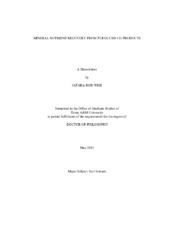| dc.description.abstract | Pyrolysis is the thermo-chemical degradation of biomass in an oxygen-free environment to product liquid, gaseous, and solid co-products. The liquid co-product, known as bio-oil, can be used as a transportation fuel. The gaseous co-product, known as synthesis gas, can be used to power the pyrolysis reactor or other machinery. The solid co-product, known as bio-char, has been studied as an amendment to enhance soil physical and chemical properties and nutrient status.
Although previous publications have described the beneficial effects of pyrolysis bio-char on soil physical and chemical properties, relatively little has been published on the recovery of mineral nutrients from pyrolysis co-products. This work quantified the recovery of feedstock nutrients (P, K, Ca, and Mg) and micronutrients (Na, Zn, Fe, Cu, and Mn) from pyrolysis co-products from various feedstocks using three distinct pyrolysis reactor designs. The reactors comprised a laboratory-scale fixed-bed reactor and two fluidized-bed reactors located in College Station, TX and Wyndmoor, PA. Nutrient recoveries, on a feedstock basis, were calculated for a comparison of reactor efficiencies. In addition to nutrient recoveries, physical and chemical properties of input biomass and of bio-char generated by each reactor were characterized through ultimate and proximate analyses.
For the fixed-bed reactor, results revealed variation among feedstocks for the recoveries of feedstock sources of macronutrients and Na, Fe, and Cu in pyrolysis co-products. Variation among species was also detected for the recoveries of feedstock sources of P, K, Ca, Mg, and Fe in pyrolysis co-products for samples pyrolyzed using the Wyndmoor reactor. For the College Station reactor, recoveries of feedstock sources of P, K, Ca, and Mg in pyrolysis co-products did not vary among species, but Zn did vary. Ultimate and proximate analyses of biomass and bio-chars generated by the three reactors revealed variation among species. Additionally, the results showed that the recovery of feedstock nutrients varied by reactor design. Statistical analysis revealed high correlations and linear relationships between the recovery of nutrients and reactor mass and energy efficiency and feedstock fiber properties. | en |


